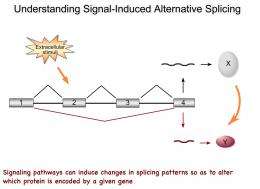Study shows how variations of same protein affect immune response

(PhysOrg.com) -- How a T cell decides to make protein X, Y, or Z can have profound effects for fighting foreign invaders or staving off dire autoimmune reactions. Researchers at the University of Pennsylvania School of Medicine have identified the steps that control how different forms of an immune cell protein called CD45, which is critical for activating the immune system when faced with pathogens, are controlled in the arc of a body’s immune response.
The shift between different forms of CD45 helps T cells function properly and also prevents hyperactivity, which could lead to the body’s own immune system attacking itself. Knowing precisely how this shifting system works has implications for understanding autoimmune and neurological diseases.
"We have identified a new paradigm for the regulation of a process called alternative splicing, which allows for a single gene to code for multiple variations of one type of protein,” says Kristen W. Lynch, PhD, associate professor of Biochemistry and Biophysics. This study appeared in an October issue of Molecular Cell.
CD45, a receptor protein that sits on the surface of T cells, is essential for immunity, for example, severe combined immune deficiency (SCID), also known as “bubble boy” syndrome, is caused by the absence of CD45.
Normal CD45 comes in five forms, all different lengths. In resting T cells, longer forms of CD45 messenger RNA (mRNA) and protein predominate, but in activated cells, the shorter form of CD45 mRNA is most abundant. “There is a spectrum of forms that shift toward full length in resting cells and towards the shorter form in activated cells,” says Lynch. Messenger RNA contains the chemical blueprint for how to make a protein.
“We knew that a protein called PSF was required for splicing out parts of CD45 RNA to make the different forms,” says Lynch. Lynch and post-doctoral fellow Florian Heyd, PhD have shown that there are additional critical components to the system that control the relative levels of the five forms of CD45 mRNA.
The first component that they identified is that another molecule called glycogen synthase kinase 3 (GSK3) found in resting T cells adds a phosphate molecule to polypyrimidine-tract binding protein-associated splicing factor (PSF). The phosphorylated PSF is then sequestered in a large protein complex by the third molecule called TRAP150. When PSF stays in this complex, the longer forms of CD45 predominate, and the T cell is ready to respond to foreign invaders. After a response, PSF loses its phosphates, and is released from TRAP150. As a consequence, PSF is then free to form the shortened forms of CD45 mRNA, which helps return the immune response to a resting state.
Splicing of CD45 mRNA involves recognition by PSF of a short length of RNA sequence called the exonic splicing silencer (ESS). Some variations within the ESS sequence are associated with autoimmune disease, especially multiple sclerosis. “We suspect that there are other spliced genes in T cells that follow the same path as CD45, and we are directing current efforts to identify them,” said Lynch.
GSK3, a critical element in T cell activation, is important in other cell types and in other signaling pathways: It has been linked to the development of tauopathies, a group of neuronal diseases that includes Alzheimer’s disease and Parkinson’s disease. GSK3 is the focus of a search for drugs that might affect these and other diseases. For example, lithium is currently used to treat bipolar disorder by inactivating GSK3 in brain cells.
“Known and potential GSK3 inhibitors may also affect the health of the immune system,” notes Lynch. “This emphasizes the importance of better understanding the variety of functions of GSK3 in the body.”

















